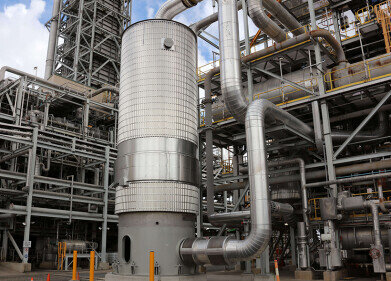Air Clean Up
Entsorga-Enteco 2009 – Focus on `Air Quality Control & Emissions Protection`
Nov 12 2009
Air quality control is one of the success stories of European environmental policy. Ever fewer air pollutants are being released into the atmosphere from power stations, waste incineration plants, industrial processes. But this is no reason to sit back. Environmental policy is still focussing above all on nitrogen compounds such as NOx and ammonia as well as particulate matter and ground-level ozone. The answers currently being offered by developers and providers of air quality control technologies to these challenges will be presented at Entsorga-Enteco - International Trade Fair for Recycling Management and Environmental Technology – from 27 to 30 October 2009 in Cologne, Germany.
Since the early 1990s, the air in the countries of the European Union has improved significantly and the emissions of the most important air pollutants have fallen dramatically. Reduction rates of 70 percent in sulphur dioxide (SO2), 45 percent in volatile organic compounds (VOC), 30 percent in nitrogen oxides (NOx) and 40 percent in particulate matter make impressive reading. In individual nations, even greater success in reducing such emissions has been achieved, such as in the Federal Republic of Germany, where for example the emissions of SO2 and particulate matter have both fallen by around 90 percent.
The best examples of this success story are provided by the waste incineration plants. Thanks to stringent legal requirements such as those defined by the 17th Federal Emission Control Ordinance (17th BimSchV) and the Technical Instructions on Air Quality Control (TA) in addition to pioneering technical innovations, Germany has succeeded in minimising emissions from thermal waste treatment. In addition to SO2 and NOx, this also applies in particular to the emissions of dioxins and furans.
Both substances can promote the development of cancer from damaged cells. Since 1990, the total emissions of these pollutants from all approx. 70 waste incineration plants in Germany has been reduced by means of state-of-the-art filter technology, for example by adding activated carbon to almost one thousandth - from 400 grammes to less than 0.5 grammes – throughout Germany. A similar improvement has also been observed in the reduction of the emissions of other more harmful substances such as arsenic, cadmium, nickel, lead and mercury.
Legislators and plant operators alike have completed a considerable part of their homework in the compulsory subject ’Clean Air’. This is no reason to rest on one’s laurels, however, according to the EU Commission and Federal Government. The objective of the 6th Environment Action Programme of the European Community 2002 to 2012 has not yet been achieved - namely, an air quality that poses no threat either to human health or to the environment. Consequently, since late-2005, the EU has been pursuing a new ’Thematic Strategy for Air Pollution Control’ that runs to the year 2020. To achieve its targets, it will be necessary, for example, to reduce the emissions of NOx and particulate matter by a further 60 percent in each case EU-wide compared with the year 2000. Accordingly, the ’National emissions ceilings directive for specific pollutants’ (NEC Directive) is being revised.
A new air quality directive has been in force since mid-2008, which brings together the old framework and multiple subsidiary directives. This directive focuses, for example, on limit, alarm and target values for a whole series of air pollutants, such as lead, benzene, arsenic, cadmium, nickel, polycyclical aromatic hydrocarbons and ground-level ozone. The directive incorporates a new annual limit set at 25 microgrammes (one millionth of a gramme) per cubic metre of air for particulate matter PM2.5 (PM = particulate matter), i.e. for the particularly fine airborne particles in the air with an aerodynamic, respirable diameter of only 2.5 micrometres (one thousandth of a millimetre).
Also undergoing revision is the directive on integrated pollution prevention and control (IPPC Directive), which standardises the procedures for plant licensing throughout Europe and which also defines the standard for the ’Best Available Technology’ (BAT) to be used.
Reducing the emissions of nitrogen oxides (NOx) presents a particular challenge. When present in abundance, this substance, which is in fact indispensable to life, is on the one hand partly responsible for producing ’acid rain’. On the other hand, it can also lead to the over-fertilisation of slow-flowing or standing waters. What is more, when combined with volatile organic compounds (VOC), nitrogen oxides are precursor chemicals in the production of ground-level ozone (summer smog).
Agriculture is responsible for a significant portion of the nitrogen compounds entering the environment via the soil as well as via ground and surface water. The main sources of nitrogen oxide from the air entering the environment are, however, traffic (50 percent), power stations (20 percent), household central heating systems (11 percent) and industrial processes (7 percent). The counter-measures in the traffic sector focus above all on tightening up exhaust emission standards for cars and small commercial vehicles (Euro V, from 2009) as well as for heavy trucks (Euro VI, from 2013) with the objective of significantly reducing the NOx and particulate matter emissions from engines.
This also applies to vehicles used in waste management for collecting refuse, street cleaning and winter gritting and road-clearing services.
And also the legal requirements for power stations, including waste incineration plants, have been tightened up further, in Germany, for example, by the 37th Federal Emission Control Ordinance, which came into effect in January 2009. According to these new regulations, new power stations, waste incineration plants and plants used for the co-combustion of waste will only be allowed to emit an average annual volume of 100 mg/m³ NOx from 2013.
Prior to this, twice the volume was allowed. If selective non-catalytic reduction (SNCR) methods were sufficient in the past, experts generally agree that the only certain way of meeting the new limit values is by using selective catalytic reduction (SCR) methods. Titanium dioxide, vanadium pentoxide and tungsten oxide, for example, are used as catalysts (reactive substances). To produce the reaction, the addition of ammonia (NH3) is required.
As an air pollutant, the nitrogen compound NH3 is not so welcome, however, as it also, just like NOx, contributes to the acidification of soil and water. In waste management, problems are created by ammoniac emissions, such as those produced by composting and fermenting organic waste. Consequently, composting plants in Germany, are required by law (Technical Instructions on Air Quality Control) to be operated in a closed design.
Furthermore, the exhaust gases have to be collected and treated, mostly in a combination of bio-filters and acid washers connected upstream. According to the 30th Federal Emission Control Ordinance, bio-mechanical plants must also be enclosed and the air they discharge cleaned. Here, it is a matter of meeting strict limit values for particulate matter, volatile organic hydrocarbons and laughing gas – a greenhouse gas. This mostly requires the use of a thermal exhaust gas purification system. Such as the regenerative thermal oxidation (RTO) method, for example, where, by passing cold raw gas and hot clean gas alternately through a heat exchanger, it is also possible to recycle heat.
The latest state-of-the-art technology for air quality control, with a special focus on plants and vehicles used in waste management and recycling, will be on show at Entsorga-Enteco - International Trade Fair for Waste Management and Environmental Technology – from 27 to 30 October in Cologne. The fair will be complemented by a professional, technical supporting programme.
Events
IWA World Water Congress & Exhibition
Aug 11 2024 Toronto, Canada
Aug 25 2024 Stockholm, Sweden and online
Sep 03 2024 Mexico City, Mexico
Sep 03 2024 Mexico City, Mexico
Sep 03 2024 San Diego, CA, USA














